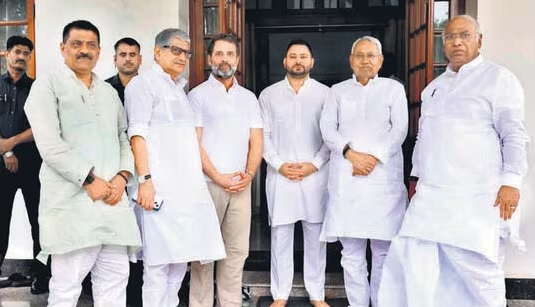
From architect to defector: Nitish Kumar’s evolving relationship with India.
Nitish’s decision dealt a significant blow to the alliance’s outlook, particularly in Bihar, the sole Hindi-belt state where the allies of INDIA held authority.
In early 2023, Bihar Chief Minister Nitish Kumar spent over three months traveling across cities, endeavoring to unite conflicting opposition factions in order to forge an alliance, a strategy that has consistently buoyed Kumar throughout his extensive career.
Kumar convened with Congress President Mallikarjun Kharge and Rahul Gandhi, as well as met with West Bengal Chief Minister Mamata Banerjee, Delhi’s Chief Minister Arvind Kejriwal, Uddhav Thackeray, Sharad Pawar, and other influential figures in pursuit of this endeavor, frequently accompanied by his Deputy Chief Minister Tejaswi Yadav.
As the collective endeavors approached the pivotal stage of seat negotiations, Kumar made a decisive move on Sunday by abandoning the Rashtriya Janata Dal, Congress, and his Left allies to establish a government with the Bharatiya Janata Party. This dealt a significant setback to the alliance’s outlook, particularly in Bihar, the sole Hindi-belt state where the allies of INDIA held authority.
Granting the BJP a strategic advantage in the state, which holds 40 Lok Sabha seats, and triggering a reshaping of Bihar’s political landscape, he has left the opposition INDIA coalition fractured just two months before the polls. With Banerjee withdrawing from an alliance in West Bengal, the Aam Aadmi Party ruling out a pact in Punjab, and Kumar’s Janata Dal (United) aligning with the BJP, the opposition coalition will face challenges in presenting a unified front against the BJP.
“A Congress leader, who preferred not to be named, emphasized the significance of the alliance’s success in Bihar following the party’s electoral setbacks in Rajasthan, Chhattisgarh, and Madhya Pradesh. “Engagement in seat negotiations with the JD(U) and RJD commenced formally on January 7,” the leader stated.
“In the view of Sanjay Kumar from the think tank Centre for the Study of Developing Societies, the 2024 Lok Sabha Election appears to lack significant competition. The focal point now revolves around the extent to which the BJP and NDA (National Democratic Alliance) can increase their seat count from 2019, while also considering if the Congress can maintain its tally from the 2014 Lok Sabha elections,” stated a post by Kumar on X (formerly Twitter).
Congress President Mallikarjun Kharge likened Kumar to a “aaya Ram gaya Ram,” a term commonly used in political spheres to describe leaders who frequently change their allegiances. Kharge noted that Kumar’s departure from the alliance was already anticipated.
“There are numerous individuals in the country who exhibit characteristics akin to ‘aaya Ram gaya Ram.’ Previously, Nitish Kumar and I were allies in our fight. Upon discussions with Lalu Prasad Yadav ji and Tejashwi Yadav ji, it became apparent that Nitish was planning to depart. Despite this foreknowledge, we refrained from disclosing anything to preserve the integrity of the INDIA alliance. Making any premature statements could have conveyed the wrong message. Lalu Prasad Yadav ji and Tejashwi Yadav ji had already informed us about this development, and today it has materialized,” Kharge stated on X.
“I stick to my word. JD(U) will meet its end in 2024. The game has only just begun,” expressed an impassioned Yadav. “I firmly believe that the people are on our side and will lend us their support.”

Efforts were made to appoint Kumar as the convener of INDIA, but these were thwarted by the Trinamool Congress, which now claims it always had doubts about his intentions. “Imagine if we had appointed him as the convener of the alliance. It would have been a blow to the INDIA group when he eventually left us,” remarked a Trinamool leader, speaking anonymously.
Almost eight months ago, on June 23 of last year, Kumar occupied a central position among the foremost leaders of 18 opposition parties. Their five-hour-long meeting at his Circular Road residence laid the groundwork for the largest opposition bloc in recent memory.
During the subsequent meeting at Bengaluru’s Taj West End, Kumar, who had served as chief minister for over 13 years, played a pivotal role. When Banerjee suggested the name INDIA for the alliance with full support from the Congress, Kumar pointed out that the words National, Democratic, and Alliance were also present in the BJP-led NDA.
During an hour-long discussion on the alliance’s name, the dominant allies refused to alter the terms National and Alliance but agreed to replace Democratic with Developmental. Consequently, the allies collectively named themselves the Indian National Developmental Inclusive Alliance. Displeased by the decision, Kumar left without attending the press conference and flew back to Patna with RJD chief Lalu Prasad on a chartered flight.
Throughout numerous meetings, Kumar urged the allies to finalize seat-sharing arrangements promptly and remained focused on advocating for pro-people issues to counter the BJP’s influence. However, on December 19, Banerjee and Kejriwal proposed Kharge as the prime ministerial candidate, leaving Kumar frustrated. Weeks later, during an online meeting of the allies, Trinamool opposed the proposal to appoint Kumar as the convener.
The coalition, relying on the unity of 28 parties to confront the formidable BJP on a national scale, must now seek a new approach. “The task ahead is challenging. The repercussions of developments in Bihar extend beyond the state’s borders,” commented a leader from a non-Congress party, requesting anonymity.




